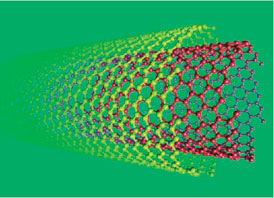|
Carbon nanotubes, found in 1991 by Sumio Iijima, represent a new building block for nanotechnology
and nanoelectronics. They may be considered as graphite sheets wrapped
into seamless cylinders. The two types of nanotubes are
multiwalled carbon nanotube (MWNT) , where many tubes are arranged in a coaxial fashion, and a
single walled nanotube (SWNT),
consisting of only a single layer. The tubes are either metallic, semimetallic or
semiconducting depending on how the graphite sheets are wrapped around.
The electrical properties of the carbon nanotubes have been exploited, among other things,
in single electron transistor
(SET) made of
ropes of SWNTs and in a room temperature transistor made of SWNT.
We have used multiwalled nanotubes for the same purpose. In year
2000, we manufactured the first MWNT SET
employing AFM manipulation and, subsequently, we have shown that such devices can equal regular metallic SETs in
their charge sensitivity.
|

Presently, our investigations in nanotubes
are focused on superconductivity and noise.
|